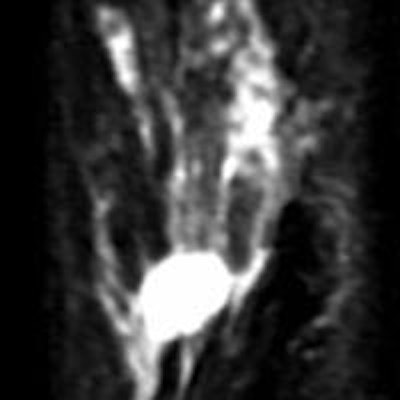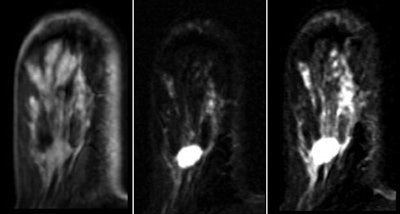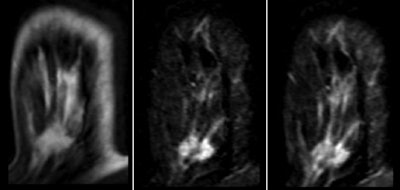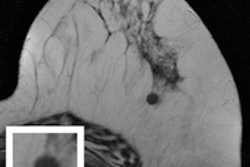
The malignancy rate is comparable for lesions detected at mammography and those found on MRI that are probably benign, which means that short-term follow-up is acceptable for women with no history of breast cancer, according to a new study published in the March issue of the American Journal of Roentgenology.
Research has shown that lesions classified as BI-RADS 3, or "probably benign," have low malignancy rates, ranging from 0.3% to 1.7%. A malignancy rate of less than 2% is acceptable in the imaging community, wrote lead author Dr. Claudio Spick, from the Department of Biomedical Imaging and Image-guided Therapy at the Medical University of Vienna, and colleagues. Malignant breast lesions initially assessed as BI-RADS 3 are reliably identified at short-term imaging follow-up when they are still at an early stage and have a favorable prognosis, they added.
Breast MRI is being used more frequently as an adjunct to mammography, and in 2003, the American College of Radiology (ACR) introduced an MRI version of the BI-RADS lexicon. Not as much is known about lesions classified as BI-RADS 3 on breast MRI, compared with BI-RADS 3 on mammography, though some papers have listed malignancy rates of 0.6% to 10% for BI-RADS 3 breast MRI lesions.
Therefore, the authors decided to clarify the imaging features of BI-RADS 3 lesions on breast MRI and evaluate the malignancy rate.
For the study, Spick and colleagues identified 1,265 patients who received breast MRI between 2002 and 2009. Of this group, 108 patients (8.5%) with a nonpalpable breast lesion classified as BI-RADS 3 at MRI were included; short-interval follow-up consisted of another breast MRI scan at six, 12, and 24 months (AJR, March 2014, Vol. 202:3, pp. 684-689).
Overall, of the 108 lesions, 107 (99.1%) were correctly assessed as probably benign, for a negative predictive value of 99.1%. Histopathology was requested for 44 patients; 43 lesions (39.8%) were classified as benign and one (0.9%) as malignant. There were no changes evident in any of the remaining 64 (59.2%) lesions during the follow-up period, according to the authors.
 Images are of a 39-year-old woman with a BI-RADS 3 lesion. Axial unenhanced (left) and subtracted two-minute (middle) and five-minute (right) T1-weighted dynamic fat-suppressed MRI shows smooth oval mass (diameter, 1.1 × 1.0 cm) in lower outer quadrant of right breast with plateau (type II) curve type. All images courtesy of AJR.
Images are of a 39-year-old woman with a BI-RADS 3 lesion. Axial unenhanced (left) and subtracted two-minute (middle) and five-minute (right) T1-weighted dynamic fat-suppressed MRI shows smooth oval mass (diameter, 1.1 × 1.0 cm) in lower outer quadrant of right breast with plateau (type II) curve type. All images courtesy of AJR.
 Same 39-year-old patient 23 months after initial study. Unenhanced (left) and subtracted two-minute (middle) and five-minute (right) axial T1-weighted dynamic fat-suppressed MRI shows increase in size of lesion (1.4 × 1.1 cm), irregular border, and washout (type III) curve type.
Same 39-year-old patient 23 months after initial study. Unenhanced (left) and subtracted two-minute (middle) and five-minute (right) axial T1-weighted dynamic fat-suppressed MRI shows increase in size of lesion (1.4 × 1.1 cm), irregular border, and washout (type III) curve type.Based on the findings, specific imaging features for BI-RADS 3 lesions at MRI -- such as round or oval shape, smooth or lobulated margins, and a type I or type II curve -- should be included in a new version of the BI-RADS lexicon, the team wrote.
The study did have some limitations; for example, it was retrospective, so additional and follow-up exams weren't necessarily done at the same institution. However, that may not be such a bad thing, according to the authors.
"This practice may better reflect the real clinical situation compared with a strict single-center study," they wrote.
What's the bottom line? Monitoring BI-RADS 3 lesions at short intervals is a viable strategy in women with no history of breast cancer.
"Short-term follow-up MRI at intervals of six, 12, and 24 months in MRI BI-RADS 3 lesions remains a strong tool with which to detect suspicious lesions," Spick and colleagues concluded.




















